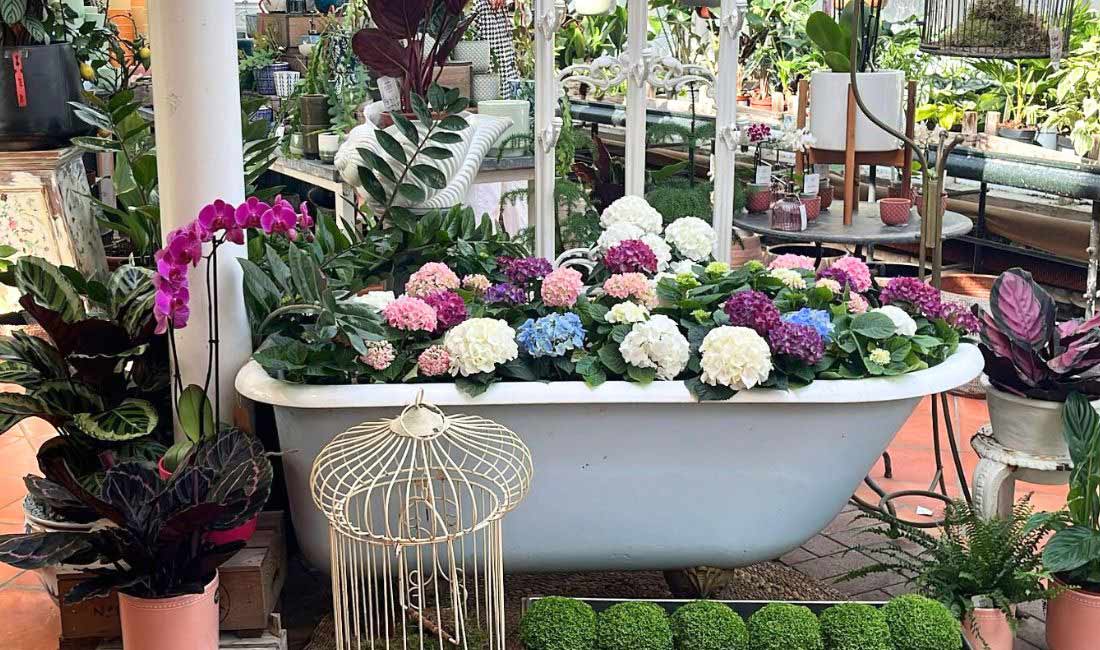
Flowering houseplants are a natural way to bring joy and happiness to any room – not only do they add colour, but some also exude fragrance, clean the air and provide an improved sense of wellbeing.
Available with many different flower types, sizes and colours, flowering houseplants can be used to complement and enhance any interior design scheme. In addition, the extensive range of beautiful interior pots and planters in all sizes, patterns, colours and materials means that there’s something for every taste and style.
With the wide range of flowering houseplants available you no longer need be content with turning your home into simply a green oasis – you can now create your very own colourful green oasis!
Caring for Flowering Houseplants
As houseplants originate from different environments all over the world it’s always worth checking the exact growing conditions preferred by your favourites but, as a general rule, flowering houseplants require better natural light than most foliage houseplants – but not direct sunlight.
Houseplants with fragrant flowers should be positioned where their perfume can be most appreciated. Depending on the size of your rooms, you may prefer not to mix plants with different fragrances, but anything goes and the choice is yours!
The majority of houseplants thrive best when grown in pots with drainage holes which are then placed in outer decorative pots with no drainage holes. Not only does this reduce the risk of water staining any furniture or windowsills but also increases the humidity around the plant, especially if you add Hydroleca clay granules or pebbles/gravel to the outer pot.
It's important to be aware that some houseplants are toxic to pets – we do recommend always checking with some online research.
Tips for ensuring the health and longevity of your flowering houseplants include:
Don’t overwater as this leads to root rot. Water only when the top few centimetres of soil feel dry to the touch.
Periodically rotate your houseplants to ensure all sides receive the same amount of light.
In addition to positioning houseplants in outer pots as described above, you can further increase the humidity around them by misting the plants on a regular basis. Remember that many of these plants originate in habitat such as forests with much higher humidity than our modern-day homes.
Feed flowering houseplants regularly with a balanced, water-soluble houseplant fertiliser, following the instructions on the packaging.
Deadhead any faded or dead flowers to encourage more blooms.
Regularly check for any pests and diseases and treat accordingly – our houseplant team are happy to advise.
Our Favourites
We stock a range of continually changing flowering houseplants – with the most popular including:
Kalanchoe – a tough, easy-to-grow, compact, succulent flowering houseplant available in numerous varieties with many different flower colours. Being budget-friendly they are often discarded after flowering, but it is possible to cut back the dead flowers and keep them to get a repeat display. As Kalanchoe are succulents it is vital to let the soil dry out between waterings.
Gardenia jasminoides – with its richly fragrant, white summer flowers and glossy evergreen leaves, this stunningly beautiful Gardenia is usually available for sale only in spring and summer. Although it can grow outside in the summer in sheltered spots, it is more frequently grown indoors due to requiring consistently warm temperatures all year round. Gardenia need moist (but not waterlogged) acidic soil and benefit from misting for high humidity.
Indoor Hydrangea – much loved for their large flower heads comprised of numerous small star shapes, and available in a range of pinks, whites and blues. With Hydrangeas the soil must be kept moist, and the plants will benefit from the rootball being plunged in water once or twice a week. Regular weekly feeding is recommended. Many indoor Hydrangea can, after flowering, be cut back and planted outside once frosts are past.
Saintpaulia (African Violet) – among the most popular of all flowering houseplants, these compact houseplants come with a range of flower types and colours including pink, white, and striking shades of purple. Be sure to water them regularly from the base, allowing the compost to dry out between watering. Deadhead on a regular basis as well as removing any dead or damaged leaves.
Phalaenopsis (Moth Orchids) – with their low maintenance and stunning dramatic, long-lasting flowers in pinks, whites, creams and terracotta colours, these excellent houseplants can become an obsession! Water only when dry. Water should be poured through the plant, allowing it to drain immediately – never sit the orchid in water. The easiest way to determine if a moth orchid needs to be watered is to feel the plant’s weight. As soon as it feels light, be sure to water it.

Clifton Nurseries Garden Centre
London, W9 2PH
0207 432 1867
Mon-Fri 9am - 5.30pm; Sat 9am - 7pm; Sun 10.30am - 4.30pm
Easter Opening Hours
Clifton Nurseries Garden Services
London, W9 2PX
